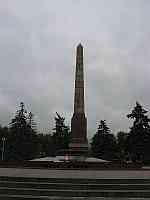
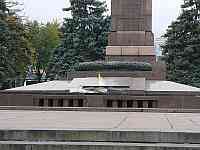
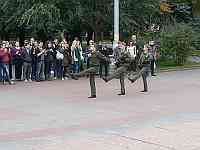
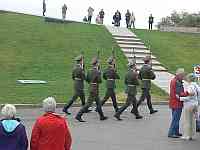
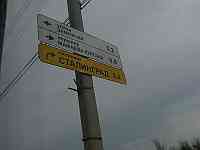
After the first part of our 3000-mile river trip, we arrived at Volgograd. The Russians seem to enjoy renaming their towns and their streets; this city was previously known as Stalingrad under which name it is probably best known for being the scene of one of the bloodiest battles of World War Two (or as named by many people that we spoke to, the Great Patriotic War). The battles and siege of the city lasted for 200 days in 1942/43, by the end of which the city had been totally destroyed and nearly two million soldiers had lost their lives. The two sides had fought to a stalemate, but the harshness of the Russian winter eventually defeated the German army who followed Hitler's express orders to never surrender. After the battle not one single building in the city remained standing; all that remained was one solitary tree in the centre of the city. A park has been created around this tree, with a memorial nearby comprising an obelisk and an 'eternal flame' which are guarded throughout every day by local schoolchildren who goose-step proudly at the ceremony of changing the guard every half-hour.
 |
 |
 |
 |
 |
Memorial in Volgograd park |
The 'Eternal Flame' at the foot of the memorial. |
Schoolchildren march to change the guard at the memorial ( watch video) |
Adults provide the guard at the main Stalingrad memorial |
Signpost to Stalingrad |
When the city was reconstructed after the war, even the alignment of the streets was changed to serve as an everlasting memorial in itself. The main memorial to the Battle of Stalingrad is just outside the city, on top of a hill which has 200 steps, one for every day of the siege. From the foot of the hill the statue of Mother Russia is visible high above you, but as you climb the steps your view is increasingly blocked by a statue of a Russian Soldier until at one point your view of Mother Russia is totally blocked and you can only proceed by passing the soldier. The symbolism is extremely powerful.
The statue of Mother Russia was planned to be much smaller, but Kruschev ordered that for the sake of national pride it must be made bigger than the Statue of Liberty. Its eventual size can be judged from my photo here, in which the people around the base are only just discernable. Naturally there is also an Eternal Flame, whose guard is changed at hourly intervals. Overall it is a splendid memorial to the soldiers who gave their all at the battle
The journey from Volgograd to Astrakhan took two days. The river is wide here but the channel is narrow and twisting and the captain decided that he would anchor at night rather than try to negotiate the tricky journey in darkness.
Astrakhan itself stands at the meeting of several transport routes. It is where the mighty River Volga flows into the land-locked Caspian Sea (which is nearly 100 feet below sea level), as well as being on the major overland routes to the North, the East, and the West. Situated next to the border with Khazakstan, it has been controlled by many different rulers over the years including the Golden Hordes of Mongolia and Ivan the Terrible.
The church inside the Kremlin (whose entrance tower leans rather badly) is as beautifully decorated as any that we saw on our travels, in contrast to which a garden gnome sits outside the front steps! On the outside wall of a smaller church nearby is an old icon; we were told that it had hung there for centuries without being affected by the weather, but fearful for its safety the authorities had moved it inside the church a few years ago; that night the precise spot where it used to hang was struck by lightning, which was taken as a sign that it should not have been removed. The icon was hurriedly replaced on the outside wall, but now with a glazed frame for protection, and there it will remain.
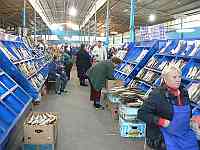 |
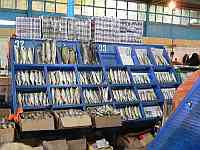 |
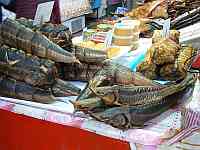 |
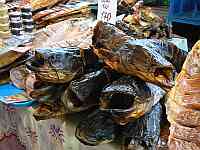 |
The fish market at Astrakhan |
The fish market at Astrakhan |
The fish market at Astrakhan |
The fish market at Astrakhan |
Astrakhan is particularly known for its fish, and we were lucky enough to visit the fish market. There was an absolutely dazzling array of fish, both fresh and dried, of all types including many whose type we couldn't even guess at. We didn't buy any fish, but we did buy ourselves a small pot of caviar to bring home with us - at a price that wouldn't have bought even a spoonful of caviar in this country.
We then travelled by coach, out towards the sea, to visit the delta region that is famed not only for its fish but also for its wild birds (most of whom had flown south for the winter before we arrived) and for its magnificent displays of lotus flowers (which had ceased flowering for the winter). We enjoyed our small-boat trip, although it had turned cold and damp before we got back to base; our guides were waiting there with copious quantities of vodka to warm us up again.
Retracing our steps towards Volgograd, after a day we made the turn West into the Volga-Don canal. Providing the only link to the Black Sea, this canal is extremely heavily used by its fleet of 'Volga-Don' 5000-ton cargo boats. One of the fleet can just be seen in the third photo here:
The canal has a steep flight of locks to its upper level, after which the channel crosses a massive reservoir 45km across, followed by a flight of locks down to the River Don. Finally we arrived in Rostov-on-Don, our ship's home port where it would spend the winter. Many of the crew had been away for up to 6 months, and the quayside was lined with banner-waving families as we moored up to the sounds of stirring music playing loudly on the ship's PA system.
Naturally we had a tour of Rostov-on-Don. The city is anxious to place itself on the tourist map; I found it hard to understand how this could best be achieved, but I imagine that they stand a better chance than does Astrakhan which has similar ambitions. Our guide told us that they built their first luxury hotel in Rostov just 5 years ago but that they have recently built two more. There did appear to be a high level of culture in Rostov with many restaurants, cinemas, theatres, and ballet/opera houses, and overall it had the bustling atmosphere that you would expect in a tourist destination so perhaps they will achieve their ambition. As an aside, one of Rostov's claims to fame is that the most beautiful women in Russia come from this region, and I have to admit that they could be right with this one!
After a day in Rostov, we were taken by coach to complete the journey to the port of Azov, where the River Don flows into the Sea of Azov which is itself an extension of the Black Sea. This busy seaport has always been tremendously important as Russia's only southern gateway to the seas, and throughout its history the area has been captured and recaptured many times. The region of Rostov was the centre of the Cossack empire, but Azov itself was held by the Turks for much of its history. Peter the Great led the Cossacks to besiege the city; and he twice captured it but was unable to hold it against the returning Turks.
Finally we were taken to Rostov Airport. The airport itself is quite large, handling many internal flights, but the International Airport is a tiny building tacked on one end. It is not large enough to cope with a planeload of incoming passengers as well as a queue of outbound tourists, who must all share the same customs and security areas, so we had to wait outside the doors until a late incoming plane had been emptied. What a contrast we saw between this tiny airport whose facilities would seem at home in the 1950's, and the huge and efficient airport at Frankfurt on our way home to Heathrow.
In 2007 we vowed to return to Russia, and we did so in 2011. Now we are determined to return again, perhaps in another 4 years time, to see how things have progressed. I would like to repeat this same journey but in the opposite direction in springtime and NOT on crutches. I wonder if it will be possible ...
All pictures on this site are © Allan Jones unless otherwise stated